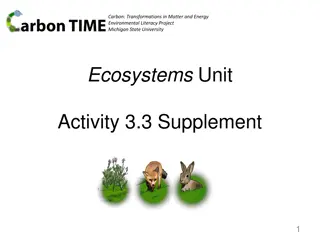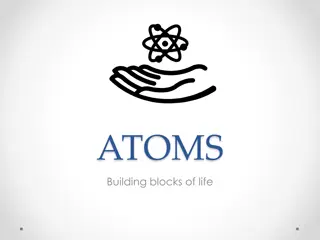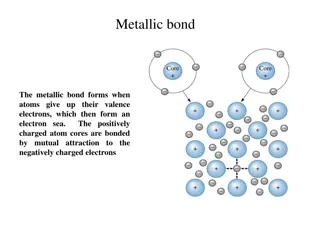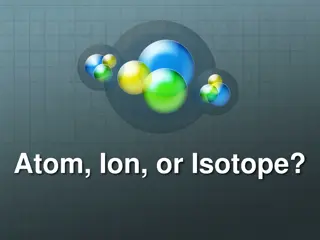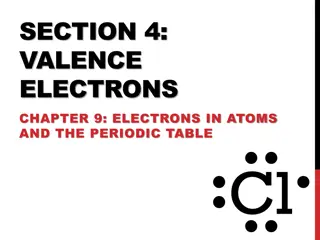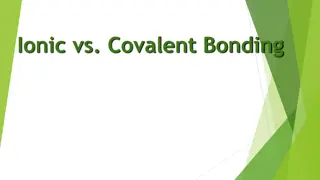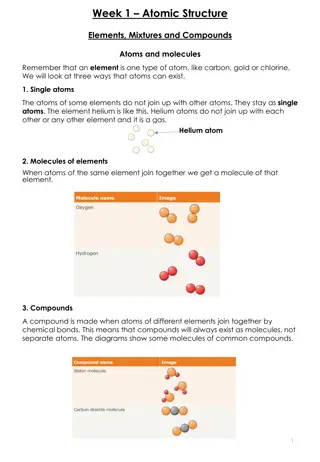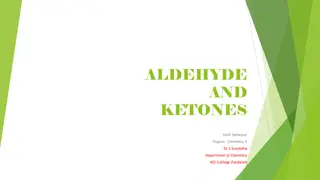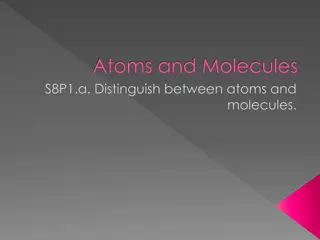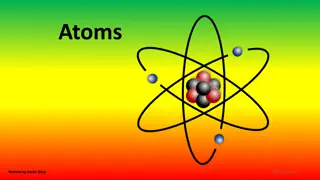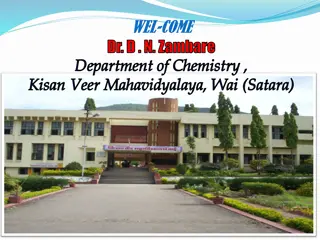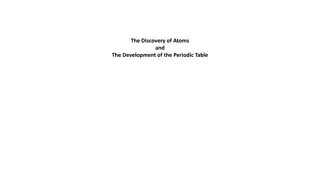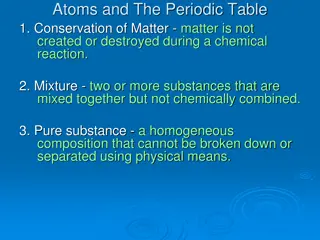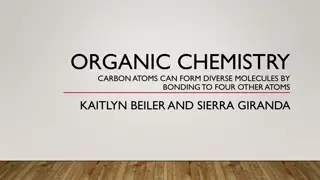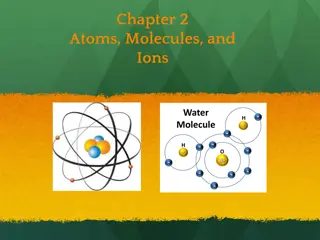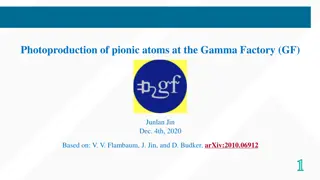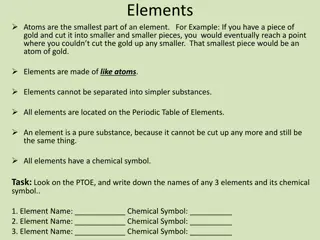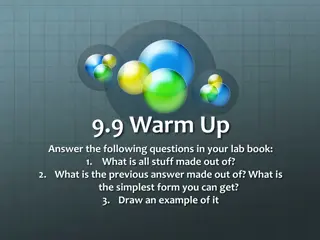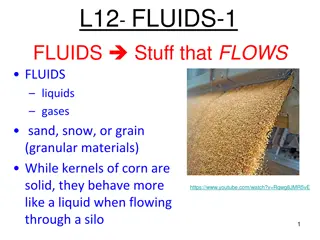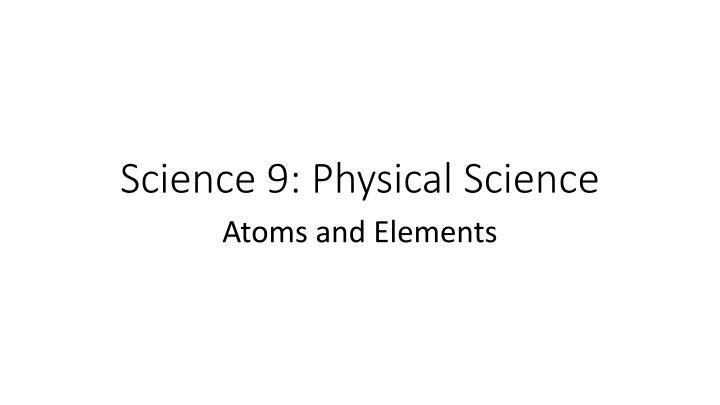
Exploring Atoms, Elements, and Isotopes in Physical Science
Uncover the historical models of matter structure, composition of everyday objects like pencils, lead, the vocabulary of atomic structure, and the distinction between elements and compounds. Delve into the world of atoms, molecules, isotopes, and their significance in scientific study.
Download Presentation

Please find below an Image/Link to download the presentation.
The content on the website is provided AS IS for your information and personal use only. It may not be sold, licensed, or shared on other websites without obtaining consent from the author. If you encounter any issues during the download, it is possible that the publisher has removed the file from their server.
You are allowed to download the files provided on this website for personal or commercial use, subject to the condition that they are used lawfully. All files are the property of their respective owners.
The content on the website is provided AS IS for your information and personal use only. It may not be sold, licensed, or shared on other websites without obtaining consent from the author.
E N D
Presentation Transcript
Science 9: Physical Science Atoms and Elements
Atoms AE 9.2 Analyze historical explanations of the structure of matter up to and including: Dalton model Thomson model Rutherford model Bohr model of the atom
What makes up A pencil. WOOD! around the outside Graphite or Lead to write Metal (Aluminum) eraser holder Synthetic rubber Eraser Paint/plastic cover -
What makes up Lead - Pb Cellulose (wood) C6H10O5(n) Aluminum Al
Vocabulary Mass Charge Electron Proton Neutron Nucleus Atom Molecule Element Compound Neutral Positive Negative Ion Isotope Periodic table
What is an atom? An atom is Some atoms lose/gain electrons giving them a particular charge. + = _______ - = _______ It has a ________ (center) composed of protons (_), neutrons, and electrons (_). A molecule is Protons and electrons have a __________.
What is an atom? An atom is the smallest constituent unit of ordinary matter that has the properties of a chemical element. Some atoms lose/gain electrons giving them a particular charge. + = cation - = anion It has a nucleus (center) composed of protons (+), neutrons, and electrons (-). A molecule is the smallest particle in a chemical element or compound that has the chemical properties of that element or compound held together by chemical bonds. Protons and electrons have a charge
Elements vs Compounds Element is a Compound is
Elements vs Compounds Element is a particular type of atom. Compound is a combination of two or more different atoms to form a molecule.
Isotopes Isotopes Carbon 12, __, __
Isotopes Isotopes are versions of an atom or an element that have the same number of protons, but different numbers of neutrons. Carbon 12, 13, 14
How is it organized? Atomic number Atomic mass number Number of electrons/protons Valence electrons Natural state metals and gases
Dalton Model Dalton's model of the atom. John Dalton proposed that all matter is composed of very small things which he called atoms. He knew nothing of atoms and electrons!
Thomson Model JJ Thomson discovered the electron! SO THERE WAS SOMETHING SMALLER THAN AN ATOM?! Plum pudding model.
Rutherford Model X Rays and Radiation appears on the scene! Dense positively charged core surrounded by negatively charged particles.
Bohr Model Electrons orbit the nucleus in rings called valence. James Chadwick came up with the theory of neutrons that would hold the atom together.
Atom-Observing Technology Microscope Cathode ray tube Mass spectrometer Hadron collider (CERN, Saskatoon)
Questions Arising form Studying Atoms Why do different molecules containing the same elements behave differently? How do atoms stick together in a molecule? Are there smaller particles than electrons, protons, and neutrons?
Quarks and Dark Matter/Energy Quarks combine to form hadrons most stable of which are called protons and neutrons. Dark matter (26.8%) is unobservable matter in our universe (doesn t respond to light). Dark energy (68.3%) accounts for universal expansion MORE OF OUR UNIVERSE IS COMPOSED OF THINGS WE CAN T OBSERVE
WHMIS and Classifying Substances AE9.1 Distinguish between physical and chemical properties of common substances, including those found in household, commercial, industrial, and agricultural applications.
WHMIS What is it?
Have you seen any of these before? What do you think they mean? Name them! WHMIS Workplace Hazardous Materials Information System It is a means of classifying substances found at home and in the workplace based on their potential hazards and health risks.
WHMIS Categories and Symbols Useful Link Category Description Compressed Gas Flammable Oxidizer Poisonous Toxic Biohazard Corrosive Reactive
Matter Substances have matter. Matter is What is mass? There are ________ and _________ properties of matter.
What are atoms, elements and compounds? Matter Substances have matter. Matter is anything that has mass and takes up space composed of combinations of atoms and elements. What is mass? Amount of matter in an object (measured in kg). There are physical and chemical properties of matter.
Identifying Common Materials What are some ways we can classify or describe materials? WE DO NOT TASTE IN A LAB! What types of properties of matter are these?
Identifying Common Materials What are some ways we can classify or describe materials? smell, colour, melting point, boiling point, density, solubility, ductility, crystal shape, conductivity, hardness, lustre, texture malleability. WE DO NOT TASTE IN A LAB! What types of properties of matter are these?
Physical Properties of Matter What is it? Any characteristic of matter that can be observed without changing the substances chemical identity. Examples? Colour, density, volume, mass, freezing point, melting point, odour,
Physical Properties of Matter Physical properties can be observed or measured without changing the composition of matter. Examples include: appearance, texture, colour, odour, melting point, boiling point, density, solubility, polarity, and many others.
Chemical Properties of Matter What is it? Characteristics of a material that become evident when it undergoes a chemical reaction or change. Examples? Changing of molecular composition, flammability, half-life (radioactivity), toxicity,
Chemical Properties of Matter are characteristics of a material that become evident when the material undergoes a chemical reaction or chemical change. Examples include: Flammability, Heat of Combustion, Toxicity, Ability to oxidize, Radioactivity, Chemical stability When a chemical change occurs we observe a new substance.
Mixtures and solutions A mixture is two molecules of a particular compound or element together. A solution is a particular molecule of a compound or element
Evidence of chemical change How can we tell a chemical change occurred and it s not just a mixture?
Evidence of chemical change change in colour, change in odour, formation of a gas or precipitate, or the release or absorption of thermal energy (heat).
Classification Lab Provide examples of how society s needs for new products can lead to scientific research and technological developments based on understanding of physical and chemical properties of matter. g. Investigate changes in the properties of materials and identify those that are indicators of chemical changes (e.g., change in colour, change in odour, formation of a gas or precipitate, or the release or absorption of thermal energy). h. Use equipment, tools, and materials appropriately and safely when conducting investigations into physical and chemical properties of substances. i. State a conclusion, based on experimental data, which supports or refutes an initial idea related to personal understanding of physical and chemical properties of matter. j. Differentiate between physical and chemical properties of matter and physical and chemical changes in matter, based on observable evidence. k. Provide examples to illustrate that scientific and technological activity related to chemistry takes place in a variety of individual and group settings within Saskatchewan.

